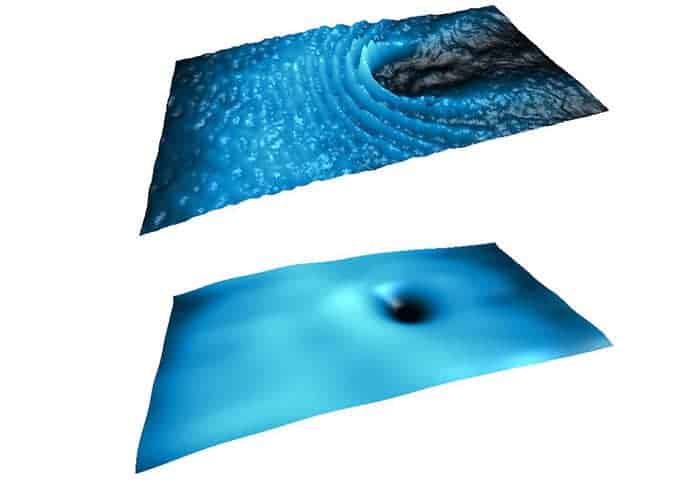Ghost surface polaritons seen for the first time
01 Sep 2021 Kirsty McGhee
The existence of ghost hyperbolic surface polaritons has been demonstrated by an international collaboration including researchers in China and the US. Based at Huazhong University of Science and Technology (HUST), National University of Singapore (NUS), National Center for Nanoscience and Technology (NCNST) and the City University of New York (CUNY), the team showed that the polariton – a hybrid light-matter quasiparticle – has a record-breaking propagation distance of three times its photon wavelength. This ghost polariton is an exciting discovery that has applications in sub-wavelength, low-loss imaging, sensing and information transfer. The full study is described in Nature.
Previously, hyperbolic polaritons, which arise from the strong coupling of electromagnetic radiation to lattice vibrations (phonons) in anisotropic crystals, had only been observed in two forms: bulk polaritons and surface polaritons. Bulk, volume-confined, hyperbolic polaritons (v-HPs) have a real out-of-plane wavevector and hence can propagate within the material supporting them. Surface-confined hyperbolic polaritons (s-HPs), however, have an entirely imaginary out-of-plane wavevector, and so decay exponentially away from the crystal surface, a property called evanescence. The hyperbolic dispersion of these polaritons is the result of the crystal’s dielectric anisotropy, which results in hyperbolic isofrequency contours in k-space (momentum space) and concave wavefronts in real space.
Most studies on v-HPs and s-HPs have been performed in thin layers of van der Waals crystals. These crystals comprise stacks of covalently bound 2D layers that are held together by weak van der Waals forces. However, in such crystal layers there is no control over the optical axis. This is the direction in which propagating light experiences no birefringence and it is typically aligned with the layers.
Friendly ghosts
Weiliang Ma and colleagues have exploited the fact that the optical axis in calcite (calcium carbonate), a bulk anisotropic crystal, can exist at an angle to the surface and can be selected at will by mechanical cutting. If the axis is indeed slanted, the optical properties of calcite in the mid-infrared region give rise to ghost hyperbolic phonon polaritons (g-HPs) that are highly anisotropic and highly collimated. These g-HPs propagate along the crystal surface and – similar to s-HPs – decay exponentially away from the surface. However, unlike conventional s-HPs, they are not purely evanescent inside the material and their wavefronts are oblique – which means they are not perpendicular to the direction of propagation.
The team was able to demonstrate the intriguing properties of g-HPs experimentally using nanoscale-resolution near-field imaging. They fabricated a gold microdisc on the surface of several calcite crystal samples and directed infrared light onto it. The disc acts as a nanoantenna, which collects the infrared illumination and “launches” two highly confined, diffraction-less polariton rays that travel up to 20 micron in different directions. In comparison, v-HP rays travel about 3 micron in van der Waals materials.READ MORE

The experiment is depicted in the figure, where to the left of the infrared beam we can see the hyperbolic polariton wavefronts, and to the right we see the two highly-collimated polariton rays. The researchers showed that the angle between the two rays increases with increasing excitation frequency and increasing angle between the optical axis and the crystal surface. Additionally, the polariton confinement can be controlled by the disc diameter.
Polariton revolution
This is the first observation of ghost polaritons and the discovery offers offer multiple ways of controlling their behaviour. “Polaritonics […] has been truly revolutionizing optical sciences in the past few years. Our discovery is the latest example of the exciting science and surprising physics that can emerge from exploring polaritons in quite conventional materials like calcite, with exciting implications for nanophotonic technologies”, says Andrea Alù of the Photonics Initiative at the CUNY Advanced Science Research Center and a co-leader of the research.
from physicsworld.com 3/9/2021

Δεν υπάρχουν σχόλια:
Δημοσίευση σχολίου